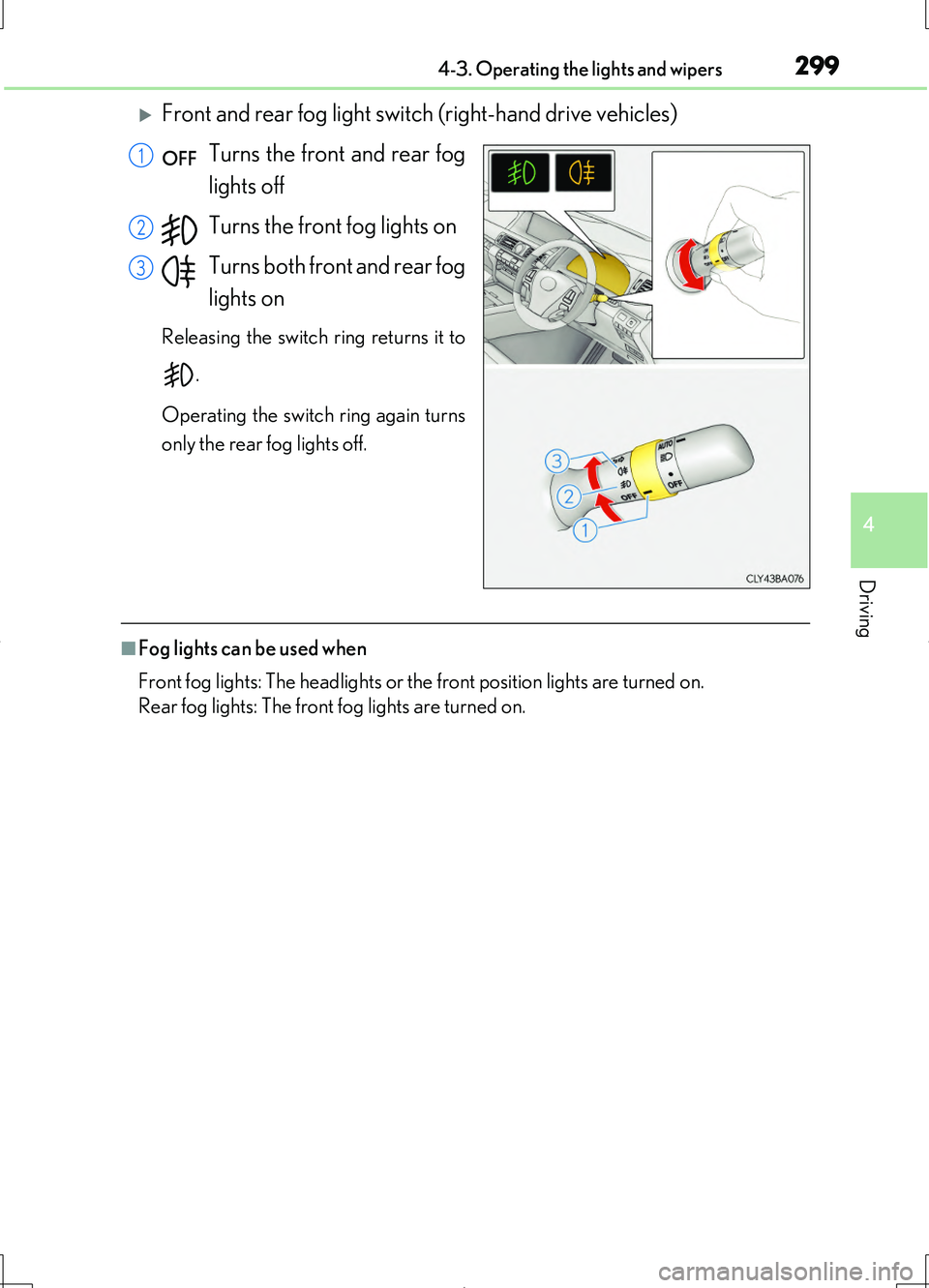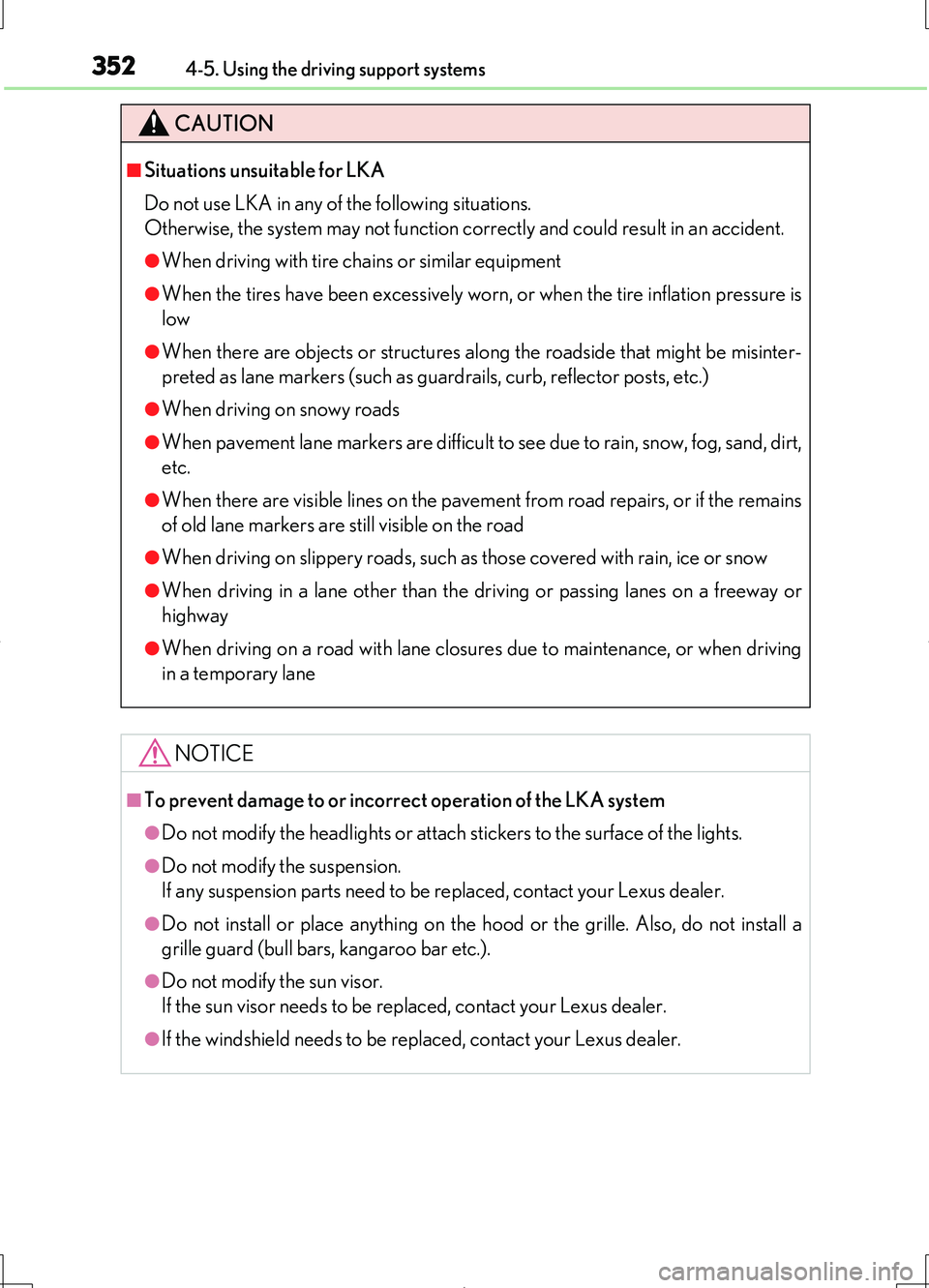2016 LEXUS LS460L fog light
[x] Cancel search: fog lightPage 245 of 708

245
4Driving
LS460/LS460L_GE (OM50G06E)
4-1. Before driving
Driving the vehicle..................... 246
Cargo and luggage ................... 257
Trailer towing .............................. 258
4-2. Driving procedures
Engine (ignition) switch ...........259
Automatic transmission
(vehicles without paddle
shift switches)............................ 264
Automatic transmission
(vehicles with paddle
shift switches)............................ 269
Turn signal lever ......................... 278
Parking brake .............................. 279
Brake Hold....................................282
Horn.................................................284
4-3. Operating the lights and
wipers
Headlight switch ........................ 285
AHS (Adaptive High-beam
System)......................................... 291
Fog light switch ...........................298
Windshield wipers and
washer ........................................ 300
Headlight cleaner switch ....... 304
4-4. Refueling
Opening the fuel tank cap..... 305
4-5. Using the driving support
systems
Cruise control .............................309
Dynamic radar
cruise control............................. 313
Dynamic radar cruise
control with
full-speed range ......................328
LKA
(Lane-Keeping Assist).......... 344
Driving mode select
switch ........................................... 354
Electronically modulated
air suspension ...........................358
Driving assist systems ..............360
PCS (Pre-Crash
Safety system) ..........................368
BSM
(Blind Spot Monitor) .............. 381
•The Blind Spot Monitor
function .................................... 387
• The RCTA function .............390
Lexus night view ......................... 393
4-6. Driving tips
Winter driving tips ..................... 399
Eco-friendly driving tips ..........403
Page 295 of 708

2954-3. Operating the lights and wipers
4
Driving
LS460/LS460L_GE (OM50G06E)
■The Adaptive High-beam System can be operated when
The engine switch is in IGNITION ON mode.
■Camera sensor detection information
●High beam may not be automatically turned off or changed to variable shade beam
in the following situations:
• When oncoming vehicles suddenly appear from a curve
• When the vehicle is cut in front of by another
• When oncoming or preceding vehicles are hidden from sight due to repeated
curves, road dividers or roadside trees
●High beam may be turned off or variable shade beam may be changed to if an
oncoming vehicle that is using fog lights without using the headlights is detected.
●House lights, street lights, red traffic signals, and illuminated billboards or signs may
cause the high beam to turn off or variable shade beam to be changed to and may
change the area that is shielded.
●The following factors may affect the amount of time taken to turn high beam on or
off, or the speed by which the shielded areas change:
• The brightness of headlights, fog lights, and tail lights of oncoming and preced-
ing vehicles
• The movement and direction of oncoming and preceding vehicles
• When a oncoming or preceding vehicle only has operational lights on one side
• When a oncoming or preceding vehicle is a two-wheeled vehicle
• The condition of the road (gradient, curve, condition of the road surface etc.)
• The number of passengers and amount of luggage
●High beam and variable shade beam may be turned on or off when unexpected by
the driver.
●Small vehicles, such as bicycles, may not be detected.
Page 296 of 708

2964-3. Operating the lights and wipers
LS460/LS460L_GE (OM50G06E)
●In the situations below, the system may not be able to correctly detect the sur-
rounding brightness levels, and may flash or expose oncoming or preceding vehi-
cles to the high beam or may continue using the low beam. Therefore, in these
situations you should consider turning the high beams on or off manually rather
than relying on the Adaptive High-beam System.
• In bad weather (rain, snow, fog, sandstorms etc.)
• The windshield is obscured by fog, mist, ice, dirt etc.
• The windshield is cracked or damaged.
• The inside rear view mirror or camera sensor is deformed or dirty.
• The camera sensor temperature is extremely high.
• Surrounding brightness levels are equal to those of headlights, tail lights or fog
lights.
• Vehicles ahead have headlights that are either switched off, dirty, are changing
color, or have are not aimed properly.
• When driving through an area of intermittently changing brightness and dark-
ness.
• When frequently and repeatedly driving ascending/descending roads, or roads
with rough, bumpy or uneven surfaces (such as stone-paved roads, gravel tracks
etc.).
• When frequently and repeatedly taking curves or driving on a winding road.
• There is a highly reflective object ahead of the vehicle, such as a sign or a mirror.
• The back of a vehicle ahead is highly reflective, such as a container on a truck.
• The vehicle’s headlights are damaged or dirty.
• The vehicle is listing or tilting, due to a flat tire, a trailer being towed etc.
■Turning the high beam on during Adapt ive High-beam System (except vehicles
with both LED headlights and near-infrared ray transmitters)
When the vehicle is traveling at a high speed, the system will turn on the inner high
beam together with the outer high beam.
■Customization
The variable shade beam can be turned off. (Customizable features P. 667)
Page 298 of 708

2984-3. Operating the lights and wipers
LS460/LS460L_GE (OM50G06E)
Front fog light switch
Turns the front fog lights off
Turns the front fog lights on
Front and rear fog light switch (left-hand drive vehicles)
Turns the front and rear fog
lights off
Turns the front fog lights on
Turns both front and rear fog
lights on
Releasing the switch ring returns it to
.
Operating the switch ring again turns
only the rear fog lights off.
Fog light switch
The fog lights secure excellent visibi lity in difficult driving conditions,
such as in rain and fog.
1
2
1
2
3
Page 299 of 708

2994-3. Operating the lights and wipers
4
Driving
LS460/LS460L_GE (OM50G06E)
Front and rear fog light switch (right-hand drive vehicles)
Turns the front and rear fog
lights off
Turns the front fog lights on
Turns both front and rear fog
lights on
Releasing the switch ring returns it to
.
Operating the switch ring again turns
only the rear fog lights off.
■Fog lights can be used when
Front fog lights: The headlights or the front position lights are turned on.
Rear fog lights: The front fog lights are turned on.
1
2
3
Page 302 of 708

3024-3. Operating the lights and wipers
LS460/LS460L_GE (OM50G06E)
■The windshield wiper and washer can be operated when
The engine switch is in IGNITION ON mode.
■Dripping prevention wiper sweep
After washing and the wiper has operated several times, the wipers operate one
more time after a short delay to prevent dripping.
However, the last sweep will not happen if the vehicle is traveling above 170 km/h
(106 mph).
■Effects of vehicle speed on wiper operation
Even when the wipers are not in “AUTO” mode, vehicle speed affects the time until
the drip prevention wiper sweep occurs.
With low speed windshield wiper operation selected, wiper operation will be
switched from low speed to intermittent wiper operation only when the vehicle is sta-
tionary.
(However, when the sensor sensitivity is adjusted to the highest level, the mode can-
not be switched.)
■Raindrop sensor
●If the wiper is turned to “AUTO” mode while the engine switch is in IGNITION ON
mode, the wipers will operate once to show that “AUTO” mode is activated.
●If the temperature of the raindrop sensor is 90 C (194F) or higher, or -15C
(5 F) or lower, automatic operation may not occur. In this case, operate the wip-
ers in any mode other than “AUTO” mode.
■If no windshield washer fluid sprays
Check that the washer nozzles are not blocked if there is washer fluid in the wind-
shield washer fluid reservoir.
■Outside rear view mirror defogger activation linked to windshield wiper operation
The outside rear view mirror defoggers automatically turn on when you operate the
windshield wipers.
The outside rear view mirror defoggers automatically turn off approximately 15 min-
utes after the wipers stop.
For details about the outside rear view mirror defoggers: P. 445
●The raindrop sensor judges the amount of
raindrops.
An optical sensor is adopted. It may not
operate properly when sunlight from the
rising or setting of the sun intermittently
strikes the windshield, or if bugs etc. are
present on the windshield.
Page 352 of 708

3524-5. Using the driving support systems
LS460/LS460L_GE (OM50G06E)
CAUTION
■Situations unsuitable for LKA
Do not use LKA in any of the following situations.
Otherwise, the system may not function correctly and could result in an accident.
●When driving with tire chains or similar equipment
●When the tires have been excessively worn, or when the tire inflation pressure is
low
●When there are objects or structures along the roadside that might be misinter-
preted as lane markers (such as guardrails, curb, reflector posts, etc.)
●When driving on snowy roads
●When pavement lane markers are difficult to see due to rain, snow, fog, sand, dirt,
etc.
●When there are visible lines on the pavement from road repairs, or if the remains
of old lane markers are still visible on the road
●When driving on slippery roads, such as those covered with rain, ice or snow
●When driving in a lane other than the driving or passing lanes on a freeway or
highway
●When driving on a road with lane closures due to maintenance, or when driving
in a temporary lane
NOTICE
■To prevent damage to or incorrect operation of the LKA system
●Do not modify the headlights or attach stickers to the surface of the lights.
●Do not modify the suspension.
If any suspension parts need to be replaced, contact your Lexus dealer.
●Do not install or place anything on the hood or the grille. Also, do not install a
grille guard (bull bars, kangaroo bar etc.).
●Do not modify the sun visor.
If the sun visor needs to be replaced, contact your Lexus dealer.
●If the windshield needs to be replaced, contact your Lexus dealer.
Page 375 of 708

3754-5. Using the driving support systems
4
Driving
LS460/LS460L_GE (OM50G06E)
■Situations in which the pre-crash safety system does not function properly
The system may not function effectively in situations such as the following:
●On roads with sharp bends or uneven surfaces
●If a vehicle suddenly moves in front of your vehicle, such as at an intersection
●If a vehicle suddenly cuts in front of your vehicle, such as when overtaking
●In inclement weather such as heavy rain, fog, snow or sand storms
●If the vehicle is skidding when VSC is not operating
●When an extreme change in vehicle height occurs
●When only part of your vehicle’s front end collides with, or contacts, a vehicle or
object in a frontal collision
●When the radar sensor moves off position due to its surrounding area being sub-
jected to a strong impact
●If an obstacle in front of the vehicle is small
●When the system judges that the driver performed a collision avoidance operation
via the accelerator pedal, brake pedal, or steering wheel
■Automatic cancelation of the pre-crash safety system
When a malfunction occurs due to sensor contamination, etc. that results in the sen-
sors being unable to detect obstacles, the pre-crash safety system will be automati-
cally disabled. In this case, the system will not activate even if there is a collision
possibility.
■When there is a malfunction in the system
The pre-crash safety system warning light will flash and warning messages will be
displayed. ( P. 607, 614)